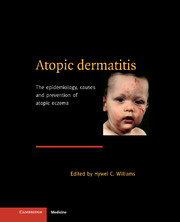Book contents
- Frontmatter
- Contents
- List of contributors
- Foreword Georg Rajka
- Preface
- Part I The nature of the problem
- Part II Descriptive studies which indicate the size of the problem
- Part III Analytical studies which point to causes of atopic dermatitis
- 8 Genetic epidemiology of atopic dermatitis
- 9 Fetal and perinatal origins of atopic dermatitis
- 10 Social factors and atopic dermatitis
- 11 The ‘old mother’ hypothesis
- 12 The possible role of environmental pollution in the development of atopic dermatitis
- 13 Atopic dermatitis in migrant populations
- 14 The role of inhalant allergens in atopic dermatitis
- 15 Dietary factors in established atopic dermatitis
- Part IV Intervention studies
- Part V Lessons from other fields of research
- Part VI Conclusions
- Additional information
- Index
- Plate section
12 - The possible role of environmental pollution in the development of atopic dermatitis
from Part III - Analytical studies which point to causes of atopic dermatitis
Published online by Cambridge University Press: 17 August 2009
- Frontmatter
- Contents
- List of contributors
- Foreword Georg Rajka
- Preface
- Part I The nature of the problem
- Part II Descriptive studies which indicate the size of the problem
- Part III Analytical studies which point to causes of atopic dermatitis
- 8 Genetic epidemiology of atopic dermatitis
- 9 Fetal and perinatal origins of atopic dermatitis
- 10 Social factors and atopic dermatitis
- 11 The ‘old mother’ hypothesis
- 12 The possible role of environmental pollution in the development of atopic dermatitis
- 13 Atopic dermatitis in migrant populations
- 14 The role of inhalant allergens in atopic dermatitis
- 15 Dietary factors in established atopic dermatitis
- Part IV Intervention studies
- Part V Lessons from other fields of research
- Part VI Conclusions
- Additional information
- Index
- Plate section
Summary
Introduction
Atopic dermatitis (AD) occurs in individuals who have a genetic predisposition and have been exposed to certain environmental influences. It is the most prevalent chronic inflammatory skin disease in childhood (Ruzicka et al., 1991). As pointed out in earlier chapters there is good evidence that this condition has significantly increased over recent decades. However, it is still unclear which factors are responsible for the increase. For AD the role of genetic predisposition to the disease is well established (Niermann, 1964; Schultz Larsen et al., 1986; Küster et al., 1990). Within the multifactorial pathogenesis several contributing external factors have been described. In addition to sex (Engbak, 1982; Erisson-Lihr, 1955; Larsson & Liden, 1980) and age (Rajka, 1989), psychosomatic influences (Young et al., 1986), exposure to aeroallergens (Vieluf et al., 1993) and food allergens (Przybilla & Ring, 1990), climatic stimuli (Young, 1980), and socioeconomic status (Williams et al., 1994) have been linked to AD. However, the postulated increase cannot be explained totally by these risk factors. Environmental contaminants and, in particular, air pollutants have been suspected as factors which possibly aggravate AD (Ring, 1991; Ring et al., 1995). The biological plausibility of this suggestion arises from the fact that most air pollutants act as nonspecific irritants as well as immunomodulators, e.g. enhancing IgE formation in animals (Behrendt et al., 1991; Suzuki et al., 1989; Takafuji et al., 1989).
- Type
- Chapter
- Information
- Atopic DermatitisThe Epidemiology, Causes and Prevention of Atopic Eczema, pp. 155 - 168Publisher: Cambridge University PressPrint publication year: 2000
- 3
- Cited by



